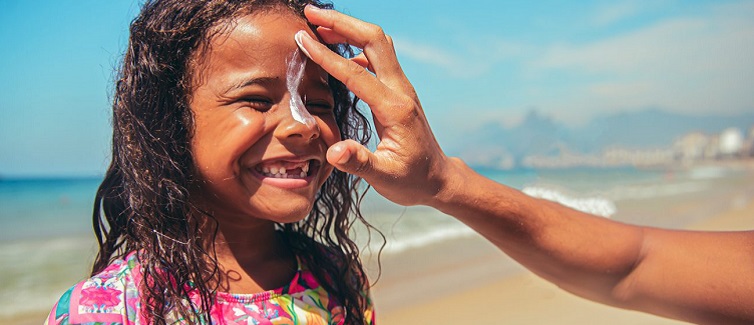The sun is shining, and or children are finally putting down their devices and video games and going outside to play.
UPMC Children’s Hospital of Pittsburgh applauds outdoor play, so just remember to protect kids from the sun’s strong rays at this time of year. According to Robin Gehris, MD, a pediatric dermatology specialist at UPMC Children’s, sunscreen should be every child’s number one accessory.
Sunscreen Is Important for Children
We know that sun exposure and especially sunburns early in life (as well as cumulatively throughout life) can increase the risk of later developing melanoma, which is a potentially life-threatening type of skin cancer.
Sun exposure also can increase the risk of developing non-melanoma skin cancers, such as basal or squamous cell cancer.
Cumulative sun exposure ages the skin prematurely and causes wrinkling and abnormal pigmentation of the skin.
Never Miss a Beat!
Subscribe to Our HealthBeat Newsletter!
Thank you for subscribing!
You can now select the specific newsletters you'd like to receive.
You are already subscribed.
Subscribe to more newsletters in our email preference center.
Sorry, an error occurred. Please try again later.
Get Healthy Tips Sent to Your Phone!
Some Kids Are More At-Risk
Certain groups of children should be especially diligent about their sunscreen. They include:
• Infants
• Children who are fair-skinned with blonde or red hair and blue or hazel eyes
• Children with a first-degree relative who has had melanoma
• Children who are on (or have a history of being on) immunosuppression medications. They are at an even higher risk of non-melanoma skin cancers, even during childhood because the suppressed immune system is not as able to eliminate certain precancerous lesions.
General Sunscreen Advice for Children
Here are some guidelines for using sunscreen on children:
• The American Academy of Pediatrics recommends that parents prevent babies under 6 months from any direct sun exposure on their skin by dressing them in lightweight long pants, long-sleeved shirts, and wide-brimmed hats or bonnets. However, if this does not shade all areas of the skin, then parents should follow the instructions below and apply the sunscreen to the small exposed areas of skin that are not covered by clothing (face, tops of hands).
• Use a sunscreen product that is “broad spectrum,” meaning that it blocks both UVA (aging) rays and UVB (burning) rays. UVA rays can penetrate glass, which is why you should apply a sunscreen to the face and exposed areas every day, even on days that might be cloudy.
• Apply and then reapply a sunscreen with SPF 15 or higher at least every 2 hours or more often if your child is sweating or swimming, even on cloudy days. Use extra caution near water and sand, which reflect the sun’s rays and can more easily and quickly lead to a sunburn.
• Find shade and avoid direct sunlight between 10 a.m. and 2 p.m., when your shadow is shorter than you are.
Should I Use Lotion or Spray Sunscreen?
• Until the FDA concludes whether they are safe in children, we do not recommend spray-on sunscreen products, which can be inhaled and rarely provide thorough enough coverage to all areas due to wind conditions and squirming during application.
• Check the expiration date on the sunscreen bottle to ensure that you are not using a product that has expired and no longer has maximal efficacy. A good way to remember the expiration date in case the stamp wears off over time is to write it on the bottle with a Sharpie marker as soon as you buy it.
Special Sunscreen Advice for Babies and Children with Sensitive Skin
• Use a product that contains only zinc oxide or titanium dioxide as the primary ingredients. These are physical or inorganic blockers.
• Avoid chemical sunscreens such as avobenzone or oxybenzone, which are chemical blockers.
• Avoid sunscreens with fragrances.
• Examples of over-the-counter products that meet these requirements are: Blue Lizard Baby or Sensitive Skin SPF 30+ or Vanicream Sunscreen, Sensitive Skin SPF 60.
Enjoy this time of year, as it seems to go by far too quickly — but do so safely with the guidelines above and you’ll be sure that you and your children get the healthiest fun out of your summer.
Editor's Note: This article was originally published on , and was last reviewed on .
About UPMC
Headquartered in Pittsburgh, UPMC is a world-renowned health care provider and insurer. We operate 40 hospitals and 800 doctors’ offices and outpatient centers, with locations throughout Pennsylvania, Maryland, New York, West Virginia, and internationally. We employ 4,900 physicians, and we are leaders in clinical care, groundbreaking research, and treatment breakthroughs. U.S. News & World Report consistently ranks UPMC Presbyterian Shadyside as one of the nation’s best hospitals in many specialties and ranks UPMC Children’s Hospital of Pittsburgh on its Honor Roll of America’s Best Children’s Hospitals. We are dedicated to providing Life Changing Medicine to our communities.
